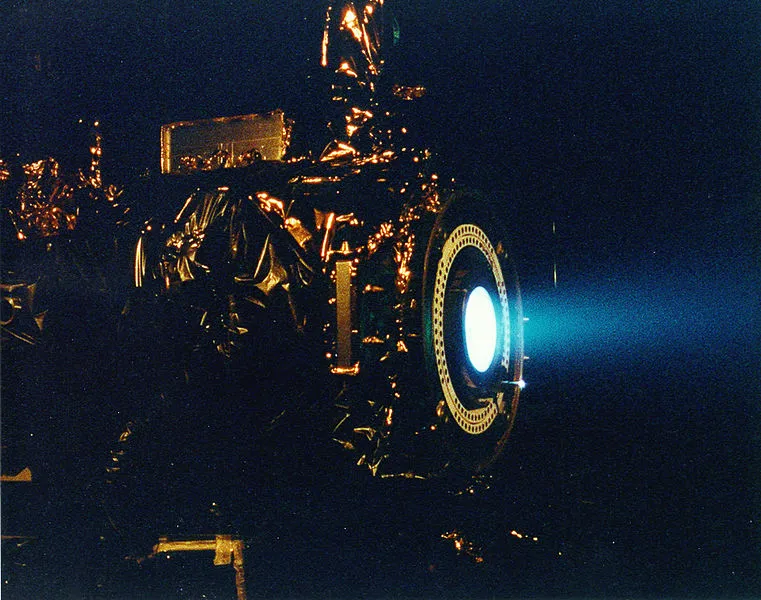On January 25, 2015, the animated comedy, The Simpsons, first aired the Season 26, 12th episode titled The Musk Who Fell to Earth. In the concluding part of the episode, Elon entered his Dragon spacecraft ( a SpaceX reusable spacecraft) and jetted out. As he was departing, one of the fictional character Lisa sassily said, "for a man who likes electric cars he sure burns a lot of rocket fuel."
Her sassy reply may not have gone down well with Elon Musk as he tweeted later.
If u saw @TheSimpsons and wonder why @SpaceX doesn't use an electric rocket to reach orbit, it is cuz that is impossible Twitter: @elonmusk
 Testing a BE-4 Rocket Engine at Night
Wikipedia CC0
Testing a BE-4 Rocket Engine at Night
Wikipedia CC0 He went ahead on the thread to show the reason that is not possible is due to the Newton's Third Law of motion.
The Newton's Third Law of motion states that for there to be an action, that you must have another action that is equal but in opposite direction.
Space Fueled Rocket vs Electric Rockets
For an object to travel out of earth's atmosphere to space, it beat the gravitational force of the massive object (earth). In order to do that, the escape velocity.
Ve= √(2GM/r)
where G= graviational constant measured in meters cubed per kilogram per second squared (m3.kg-1.s-2) and has an approximated value of 6.67 x 10-11m3.kg-1.s-2
M= mass of the body where the object is escaping from in kg
r= the radius or centre of the body's distance to where the object is located in km
The earth radius R= 6371 km, acceleration due to gravity = 9.8 m/s2 = 0.0098 km/s2
The Earth's escape velocity or speed
se =√(2gR)= √[2(0.0098 km/s2)(6371 km)]
= √(124.872 km2/s2)
= 11.186 km/s
The value of the velocity needed to travel out from earth to space is given by the value of 11.186 km/s (40,279 km/h or 25,020 mph or 6.95 miles/second).
You will need to propel the spacecraft to an acceleration which is higher than 11.2km/s to enter orbit.
Spacecraft weighs many tonnes, eg. SpaceX Falcon Heavy weighs, according to the SpaceX's webiste, 1,420,788 (3,125,735 lb) and has the capacity to lift more than 64 metric tonnes (64,000kg or 141,000 lb). The weight of that specified payload weighs more than a fully loaded (both passenger, crew and fuel) Boeing 737 jetliner.
Every space engineer or scientists knows the process of achieving space velocity is one that is critical. It involves a tremendous amount of fuel which scientists/researchers are fervently looking for an alternative to using a more efficient propulsion technology or lighter fuel to achieve.
So, why won't Elon Musk, known for his top of the class luxurious electric car consider building an electric rocket that uses electricity instead of the fuel to blast off the Earth?
The Newton Third Law Problem
 Rocket launch, notice the huge fuel burn exhaust:
Pixbay
Rocket launch, notice the huge fuel burn exhaust:
Pixbay The Newton Third Law looks at the force exerted on another body and the corresponding opposite reaction which takes place. The rocket's engine accelerates fuel downwards and creates a vast thrust in the upward direction which is huge enough to generate the escape velocity needed to get into orbit.
In the case of an electric rocket, we would need something to push out in the downward direction to create upward movement.
We can borrow from the similar technology of helicopters by building a rotor that creates vertical thrust through spinning and pushing air downwards.
Why are we not using this method? The answer is simple; they are not easy to implement. It requires a massive ton of materials (batteries, etc.) to create such a machine.
The current SpaxeX Falcon heavy has 28 engines which are capable of producing a thrust of 934 kilos Netwon (kN) 22,819 kN sea level and 24,681 kN. The first stage booster propellant mass was 395,700kg with a burn time of 162 seconds, and the second stage was 92,670kg with the burn time of 397 seconds, which makes a total of 488,370kg mass for the fuel used in less than 10 minutes.
Currently, the world does not have the technology to store such an amount of energy required for an electric all-powered rocket.
We all know the "pushing" out of gases (at extreme speeds/rates) by burning fuel creates a "push back" on the rocket to propel it forward.
 Testing an ion engine in a vacuum chamber at NASA's Jet Propulsion Laboratory. You can observe the faint blue glow which is the ions emitted by the engine:
Wikipedia CC0
Testing an ion engine in a vacuum chamber at NASA's Jet Propulsion Laboratory. You can observe the faint blue glow which is the ions emitted by the engine:
Wikipedia CC0 Simulating this electrically, involves the pushing out of charged particles such as ions. These ion thrusters may be powered by a radioistope thermoelectric generator (RTG). It is an electric generator that which converts heat produced by some specific radioactive materials to produce electricity with no need of a moving part in it.
These electric ion thrusters are only used in space for low thrust application such positioning and orientation of satellites in space.
It can only be used in space as the little thrust cannot overcome air resistance. So the idea of using it to blast a rocket into space is something we may not achieve in decades to come.
References
- Elon Musk debunks electric space rockets after Simpsons lampooning
- Elon's Dragon V2 Space Machine
- Escape Velocity
- SpaceX Falcon Heavy
- Falcon Heavy Overview
- Ion Thruster
If you write STEM (Science, Technology, Engineering, and Mathematics) related posts, consider joining #steemSTEM on discord here. If you are from Nigeria, you may want to include the #stemng tag in your post. You can visit this blog by @stemng for more details. You can also check this blog post by @steemstem here and this guidelines here for help on how to be a member of @steemstem. Please also check this blog post from @steemstem on proper use of images devoid of copyright issues here
